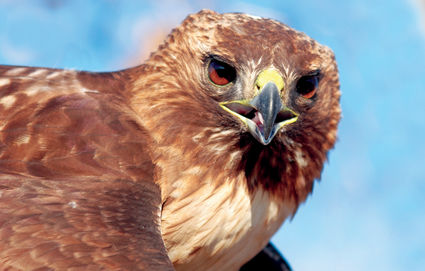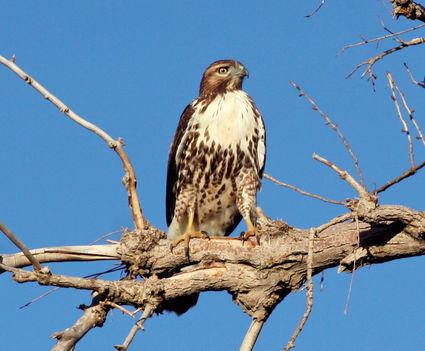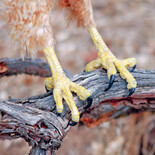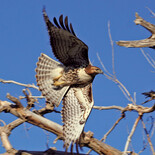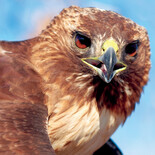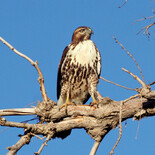Kwanazi, the Red-tailed Hawk of Tehachapi's past, present and future
Land of Four Seasons
November 23, 2019
The young Nuwä woman trotted lightly along the slope, on a game trail that human steps had enlarged to a footpath. When she reached the top of the oak-dappled hill, she paused by an old leafy tree with weathered gray bark, its branches sturdy against the blue Tehachapi sky.
As her experienced eyes took in the familiar landscape before her, she saw a large bird with outstretched wings circle towards her. Though the bird was a few hundred feet above the valley floor below, it was not far above the Native youth on her hilltop overlook.
The Nuwä looked up into the sky, her long dark hair trailing down her shoulders and back. She watched the hawk, then pursed her lips and made a downward slurring shriek-like whistle. The hawk answered back with an almost identical "kee-eeeee-aarr!" call.
"Kwanazi, hin pu-ke-enam-me?" she called out to the bird with a smile, wishing she could fly like it. She said its Nuwä name, Kwanazi, and asked "What do you see?" The hawk didn't answer back until she spoke again in its language, "keeeeee!" she whistled, and the hawk screamed "keee-eeeee-aar" and disappeared on the afternoon air currents. . .
Kwanazi (pronounced kwa-NAH-zee) is the Nuwä, or Tehachapi Indian word for the common raptor that we call a Red-tailed Hawk. The ending "azi" is commonly attached at the end of words that indicate an animal, and "kwasa" is the word for tail, so the ancient Nuwä apparently named this bird for its distinctive red tail, as did the settlers who followed.
For many thousands of years, Red-tailed Hawks have done their circle-soaring above the landscapes of the Tehachapi Mountains. They watched from above as the grasses grew lush and green in the spring, then faded to golden in the sun-drenched summer days, and were blanketed white with snow on some winter days. And the color change continued on, season after season, as the seemingly endless yearly cycle repeated itself.
Red-tailed Hawks (Buteo jamaicensis) are the most omnipresent birds of prey in our area. They are year-round residents with many successful nests every spring, and their numbers also swell in winter with the arrival of migrant Redtails from higher elevations or more northerly locations.
Kwanazi can be found all throughout the Tehachapis. They aren't a bird of the dense forest, but the Tehachapi area's Valley Oak savannahs, Blue Oak/Gray Pine woodlands, grasslands and other mixed or open habitat is ideal for these raptors, which can reach two feet tall with a four-foot wingspan.
When Nuwä (Kawaiisu or Paiute) Indian people worked with ethnobotanist Dr. Maurice Zigmond in the 1930s to document the language, they described Kwanazi as being a "squirrel hawk," suggesting that they had witnessed Redtails preying upon California ground squirrels. Adult ground squirrels are not their favorite prey – they bite and can usually reach the safety of a burrow – but young ground squirrels are easier. Red-tailed Hawks are extremely adaptable in their diet and have been documented eating rodents and other mammals, birds, reptiles, amphibians, insects, carrion and more.
Over the millennia that the Nuwä and Kwanazi co-existed in the Tehachapi Mountains, they would actually be competitors for a few choice game animals, like California Quail or cottontail rabbits, and a bow hunter might occasionally provide an opportunistic Redtail with a meal if the hawk got to a downed rabbit or bird first.
As people who spent much of their lives outside, the Nuwä would encounter Kwanazi on a daily basis, and the hawk's familiar whistling cry would be part of the soundtrack of their lives. The trailing away scream of a circling Redtail remains part of the Tehachapi soundtrack to this day, even with all of our mechanical sounds from trains, cars, trucks, planes, power tools, etc. In the quieter times of earlier centuries, the Redtail's cry of freedom from aloft must have been even more ubiquitous.
During those countless earlier years, before the arrival of European settlers, people had little impact on the terrain of the Tehachapi Mountains that Kwanazi flew over. Small villages with thatched willow houses, footpaths, lone hunters stalking prey, families out foraging, occasional curling smoke drifting upwards from cooking fires. . . these were among the only manmade sights that greeted a Redtail on the wing.
But after 170 years of settlement and development that began about 1850, the world that unfurls below a Kwanazi circling over Tehachapi is very different. Humans have added a railroad, highways, houses, roads, power lines, fences, farms, businesses, parking lots, wind turbines and more. The change in some places is staggering and absolute.
And yet. . . there are many areas that have changed little. The yearly rhythms of oak trees and wildflowers, quail coveys and mule deer herds continue on. If you spend time outdoors, especially in the hills and wilder places, Red-tailed Hawks abide and you will cross paths with them daily.
They may be perched on an oak tree or utility pole (Edison pines, I call them). Or plunging suddenly downward to the ground to seize an incautious rodent and then glaring fiercely at any creature that might covet their catch. Or just coiling through the sky in the distance, wings fully outspread and cinnamon red tail feathers splayed.
And as Red-tailed Hawks spiral their way through time, we still want to say "Kwanazi, hin pu-ke-enam-me?" and wish we could fly like them. . .
Enjoy the beauty of life in the Tehachapi Mountains.
Jon Hammond is a fourth generation Kern County resident who has photographed and written about the Tehachapi Mountains for 38 years. He lives on a farm his family started in 1921, and is a speaker of Nuwä, the Tehachapi Indian language."Kwanazi, hin pu-ke-enam-me?" she called out to the bird with a smile, wishing she could fly like it. She said its Nuwä name, Kwanazi, and asked "What do you see?" The hawk didn't answer back until she spoke again in its language, "keeeeee!" she whistled, and the hawk screamed "keee-eeeee-aar" and disappeared on the afternoon air currents. . .
Kwanazi (pronounced kwa-NAH-zee) is the Nuwä, or Tehachapi Indian word for the common raptor that we call a Red-tailed Hawk. The ending "azi" is commonly attached at the end of words that indicate an animal, and "kwasa" is the word for tail, so the ancient Nuwä apparently named this bird for its distinctive red tail, as did the settlers who followed.
For many thousands of years, Red-tailed Hawks have done their circle-soaring above the landscapes of the Tehachapi Mountains. They watched from above as the grasses grew lush and green in the spring, then faded to golden in the sun-drenched summer days, and were blanketed white with snow on some winter days. And the color change continued on, season after season, as the seemingly endless yearly cycle repeated itself.
Red-tailed Hawks (Buteo jamaicensis) are the most omnipresent birds of prey in our area. They are year-round residents with many successful nests every spring, and their numbers also swell in winter with the arrival of migrant Redtails from higher elevations or more northerly locations.
Kwanazi can be found all throughout the Tehachapis. They aren't a bird of the dense forest, but the Tehachapi area's Valley Oak savannahs, Blue Oak/Gray Pine woodlands, grasslands and other mixed or open habitat is ideal for these raptors, which can reach two feet tall with a four-foot wingspan.
When Nuwä (Kawaiisu or Paiute) Indian people worked with ethnobotanist Dr. Maurice Zigmond in the 1930s to document the language, they described Kwanazi as being a "squirrel hawk," suggesting that they had witnessed Redtails preying upon California ground squirrels. Adult ground squirrels are not their favorite prey – they bite and can usually reach the safety of a burrow – but young ground squirrels are easier. Red-tailed Hawks are extremely adaptable in their diet and have been documented eating rodents and other mammals, birds, reptiles, amphibians, insects, carrion and more.
Over the millennia that the Nuwä and Kwanazi co-existed in the Tehachapi Mountains, they would actually be competitors for a few choice game animals, like California Quail or cottontail rabbits, and a bow hunter might occasionally provide an opportunistic Redtail with a meal if the hawk got to a downed rabbit or bird first.
As people who spent much of their lives outside, the Nuwä would encounter Kwanazi on a daily basis, and the hawk's familiar whistling cry would be part of the soundtrack of their lives. The trailing away scream of a circling Redtail remains part of the Tehachapi soundtrack to this day, even with all of our mechanical sounds from trains, cars, trucks, planes, power tools, etc. In the quieter times of earlier centuries, the Redtail's cry of freedom from aloft must have been even more ubiquitous.
During those countless earlier years, before the arrival of European settlers, people had little impact on the terrain of the Tehachapi Mountains that Kwanazi flew over. Small villages with thatched willow houses, footpaths, lone hunters stalking prey, families out foraging, occasional curling smoke drifting upwards from cooking fires. . . these were among the only manmade sights that greeted a Redtail on the wing.
But after 170 years of settlement and development that began about 1850, the world that unfurls below a Kwanazi circling over Tehachapi is very different. Humans have added a railroad, highways, houses, roads, power lines, fences, farms, businesses, parking lots, wind turbines and more. The change in some places is staggering and absolute.
And yet. . . there are many areas that have changed little. The yearly rhythms of oak trees and wildflowers, quail coveys and mule deer herds continue on. If you spend time outdoors, especially in the hills and wilder places, Red-tailed Hawks abide and you will cross paths with them daily.
They may be perched on an oak tree or utility pole (Edison pines, I call them). Or plunging suddenly downward to the ground to seize an incautious rodent and then glaring fiercely at any creature that might covet their catch. Or just coiling through the sky in the distance, wings fully outspread and cinnamon red tail feathers splayed.
And as Red-tailed Hawks spiral their way through time, we still want to say "Kwanazi, hin pu-ke-enam-me?" and wish we could fly like them. . .
Enjoy the beauty of life in the Tehachapi Mountains.
Jon Hammond is a fourth generation Kern County resident who has photographed and written about the Tehachapi Mountains for 38 years. He lives on a farm his family started in 1921, and is a speaker of Nuwä, the Tehachapi Indian language.


